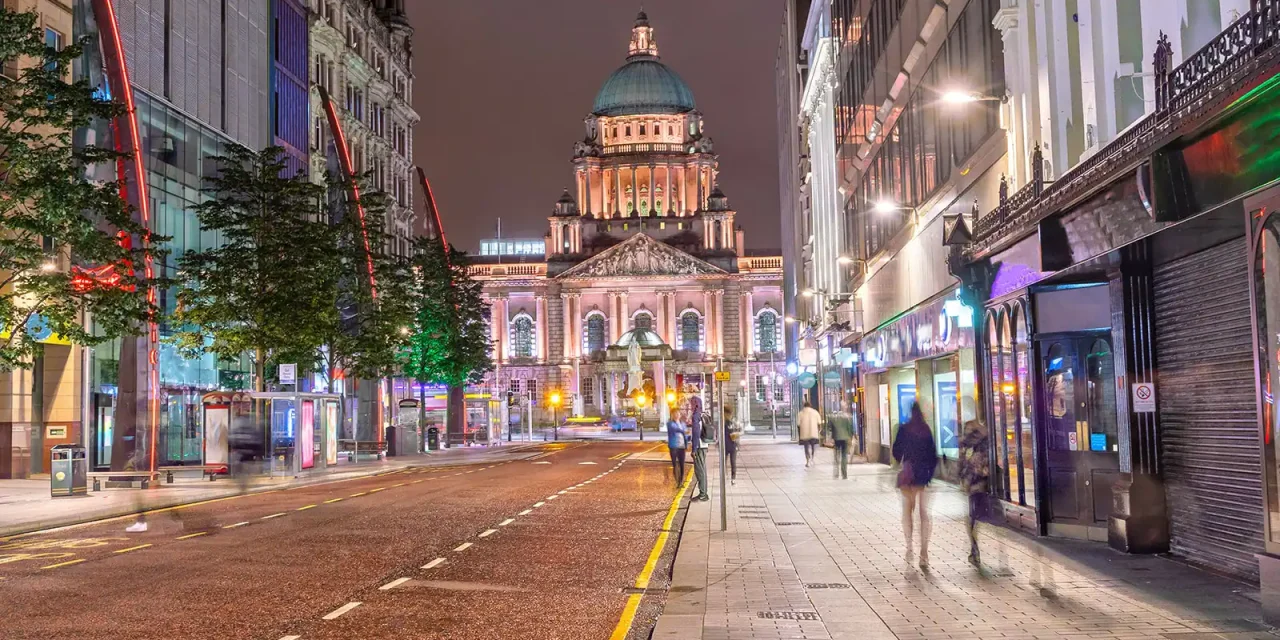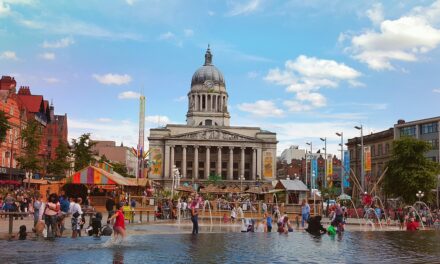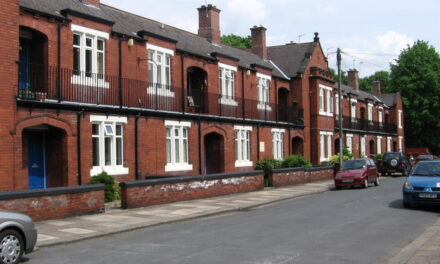Belfast
Belfast first appears in FTHM Edition 83
Belfast is situated on the banks of the River Lagan and is the capital of Northern Ireland. In 2019, it had a population of 343,542, but it is true to say that its prosperity has suffered because of conflict between Republicans (Catholics) and Loyalists (Protestants) which is commonly known as the Troubles. The name Belfast originates from Irish (Beal Feirste) and means ‘mouth of the sand-bank ford’.
There is clear evidence that the site where Belfast now stands has been occupied since the Bronze Age and remains of Iron Age hill forts can still be seen amongst the surrounding hills. One can also see The Giant’s Ring which is a 5,000-year-old henge and is located near Belfast. However, during the Middle Ages the place was of little importance.
Belfast was established as a town in 1613 by Sir Arthur Chichester who owned Belfast Castle at this time. Scottish Presbyterians and French Huguenot refugees started to produce linen and were involved in a 3-way trade with the West Indies (slave plantations) and Baltimore and New York. The profits from the trade financed improvements in the town’s infrastructure. The nickname of the town was actually Linenopolis.
But things were never easy in Belfast with the United Irishmen calling for Catholic emancipation and independent representation – there was also a growing disaffection towards the Crown.
Interestingly, aspects of the seventeenth century remain like the alleyways off High Street, the 1st Presbyterian Church in Rosemary Street and the Charitable Society poorhouse on North Queen Street.
In the nineteenth century, Belfast witnessed rapid industrial growth which attracted many landless Catholics to settle in the West of the town. At the same time, many English and Scottish workers also moved to Belfast to take up plentiful employment. Unfortunately, attempts to repeal the Acts of Union and to restore a Parliament in Dublin heightened sectarian tensions.
By early nineteenth century, Belfast had become a major port and played an important role in the Industrial Revolution in Ireland when it was briefly the biggest linen producer in the world. When Belfast gained city status in 1880, it had become not only a major centre for production of linen, but was also known for tobacco processing, rope making and, of course, shipbuilding e.g., the RMS Titanic was built in the famous Harland and Wolff shipyard.
Notably, there were deadly sectarian riots in cities like Belfast, Liverpool and Glasgow as the Great Famine had caused large scale Irish Catholic immigration. In 1919, workers in the aforementioned cities struck for a 10-hour reduction in the working week. But sectarian trouble had been brewing as early as 1912 when Belfast City unionists demonstrated against a Dublin parliament. Ironically, more potential problems were avoided by the onset of the Great War, but to this day the sacrifices of UVF (Ulster Volunteer Force) continue to be commemorated in the city (Somme Day) by loyalist and union organisations.
When in 1921, Ireland became the Irish Free State, Belfast became the capital of the remaining six counties which are now known as Northern Ireland in the UK. But as Ireland broke up into two, 500 people were killed in disturbances in Belfast which was the highest figure until the Troubles of the late 1960s onwards.
During the second World War, the city of Belfast was heavily bombed and on one night in 1941, around 1,000 people were killed and many citizens were left homeless. The Belfast Blitz also resulted in damage or destruction of shipyards, an aircraft factory, a lot of the city’s housing stock and also destroyed much of the old town centre.
At the end of World War Two, the cost of regeneration was met by the British Exchequer rewarding service by the Unionist government. This money paid for: universal healthcare, a comprehensive social security system, public construction and enhanced access to secondary and further education. But it can be argued, that because of heightened expectations, more and more people became unhappy with the Unionist’s record on civil and political rights in the 1960s.
As is well documented elsewhere, sectarian conflict between Catholics and Protestants raged from the late 1960s to 1998 with casualties resulting on both sides. It is important to mention that the British Army (deployed in 1969) was also responsible for some civilian deaths. During this period, Belfast was a very dangerous place to be and over 1,600 people were killed in political violence in the city between 1969 and 2001.
Two important occurrences namely the IRA ceasefire in 1994 and the signing of the Good Friday Agreement in 1998, led to improved investor confidence in Belfast which resulted in economic growth and regeneration of the city centre. Some developments include: the Cathedral Quarter, Victoria Square and also regeneration of the Titanic Quarter as well as the erection of the skyscraper known as the Obel Tower. Peace has also meant an increase in tourism and Belfast is now one of the most visited destinations in Europe. But unfortunately, the introduction of mass-produced and cotton clothing has resulted in the decline of Belfast’s international linen trade.
Today, there is roughly an equal number of both Catholics and Protestants and many areas are still segregated along ethnic, political and religious lines – especially in Working Class ones. Most Catholics live in West Belfast whilst East Belfast is predominantly a Protestant area. These divisions are marked by flags, murals and graffiti and are segregated by walls known as “Peace Lines”. Some ethnic minorities (Polish, Chinese, Indian, and Eastern Europeans) also live in the city.
The Cathedral Quarter is the main hub for cultural activity and hosts a yearly visual and performing arts festival. Some other important quarters are: the Queen’s Quarter in South Belfast (with a large student population) which hosts the annual Belfast International Arts Festival/is home to the Botanic Gardens and the Gael Tacht Quarter in West Belfast which promotes and encourages the use of the Irish language.
If you fancy a night out in Belfast, you could travel down the Golden Mile where there are great bars and restaurants to be discovered. Also, since 1998, Lisburn Road has become the city’s most exclusive strip.
The architecture in the city can be divided into Georgian, Victorian, Edwardian and Modern. In fact, many of Belfast’s public buildings are small Georgian ones whilst the Linehall library is a good example of Victorian architecture. The City Hall exemplifies the Edwardian style whilst the Waterfront Hall is Modern in nature. The Cathedral Quarter possesses many of the oldest buildings in the city.
The city boasts over 40 public parks like the Victorian Botanic Gardens and Lagan Valley Regional Park where you can spend many a happy and inexpensive hour.
If you are looking for entertainment, there is plenty on offer in the form of music, art, poetry and live sport. For example, you could see and hear the Ulster Orchestra (only full-time symphony orchestra in Northern Ireland) or you could go watch football, Gaelic games, ice hockey, cricket or maybe rugby.
People who appreciate animals can visit Belfast Zoo which carries out important conservation work and is involved in breeding programmes that aid the survival of species that are under threat.
So, Belfast is a progressive city with two universities, a FE college, 184 primary schools and many secondary and grammar schools. It can easily be accessed by air, ferry and car so why not pay the city a visit and be pleasantly surprised!
* With a lot of help from Wikipedia





Recent Comments